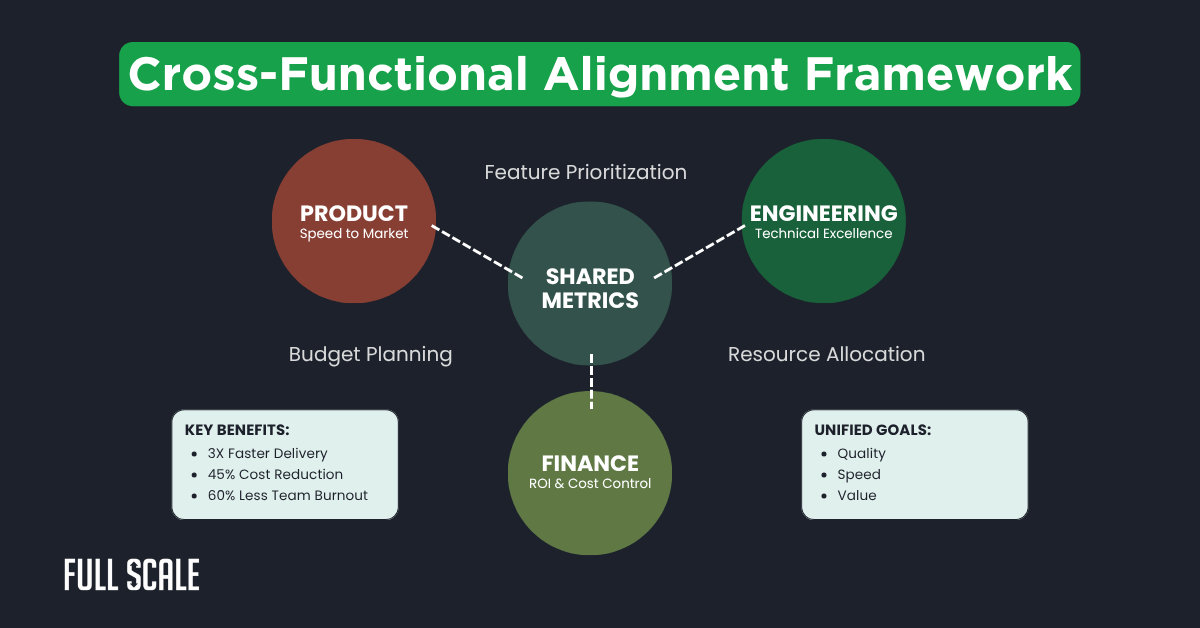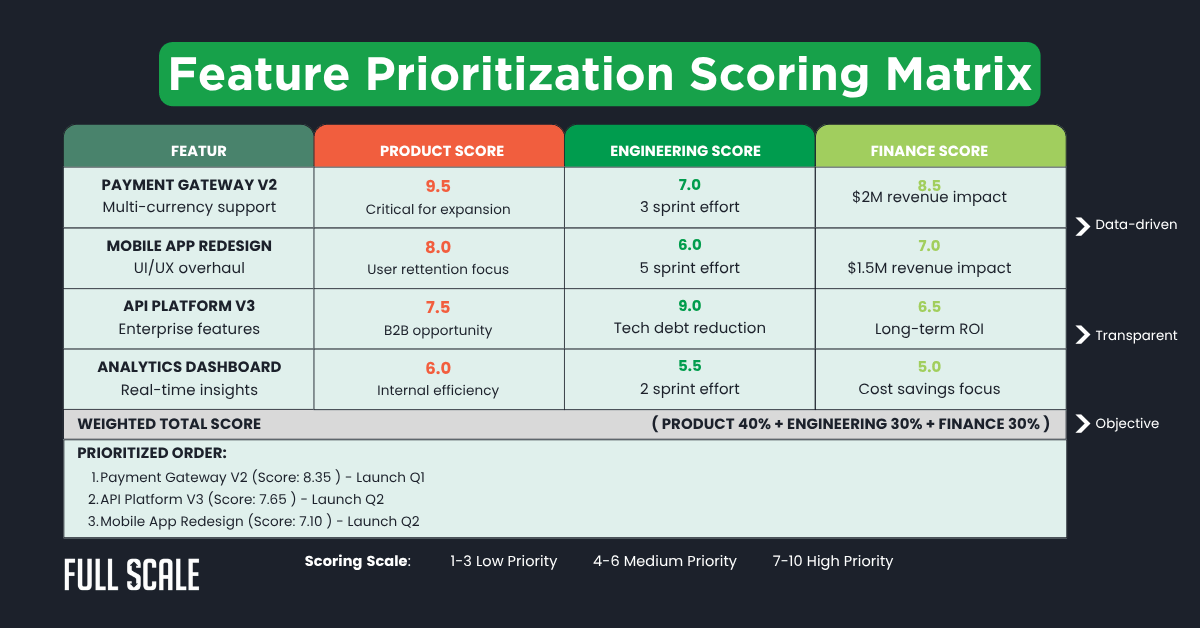Last Updated on 2025-06-09
According to McKinsey’s 2024 Digital Transformation Report, 68% of software projects fail due to departmental misalignment.
The Project Management Institute found that companies with strong cross-functional alignment achieve 2.5x better project success rates. Scalable software delivery requires seamless coordination between Product, Engineering, and Finance teams to overcome these challenges.
Organizations pursuing scalable software delivery face three critical forces: quality demands from engineering, speed requirements from product, and cost constraints from finance.
Without proper cross-functional team alignment, these competing priorities create friction that delays releases, inflates budgets, and frustrates teams.
Companies achieving effective engineering-product-finance collaboration report dramatically better outcomes across all metrics.
What You’ll Learn in This Guide:
- Proven frameworks for aligning Product, Engineering, and Finance teams
- How to identify and fix misalignment warning signs before they derail projects
- Practical strategies for implementing cross-functional metrics and processes
- Technology solutions that enable seamless collaboration
- Real-world case studies demonstrating 3x delivery improvements
- Specific leadership techniques for CTOs driving organizational change
- Measurement approaches to track and sustain alignment success

The Alignment Gap: Understanding Divergent Priorities for Scalable Software Delivery
Each department views scalable software delivery through a different lens. Understanding these perspectives forms the foundation for successful cross-functional team alignment. The gap between these viewpoints often determines project success or failure in software development scaling.
Engineering Perspective: Technical Excellence and Scalability
CTOs and engineering leaders face mounting pressure to achieve scalable software delivery. They must balance immediate delivery needs with long-term system health. Technical debt accumulates when shortcuts compromise architectural integrity. Resource allocation becomes increasingly complex as software development scaling accelerates.
A typical 300-employee FinTech CTO manages competing demands daily. Engineering teams struggle with legacy code while supporting explosive growth. Technical debt often consumes 40% of sprint capacity. New feature development slows despite urgent engineering, product, and finance collaboration needs.
Engineering’s Core Priorities:
- System architecture supporting 10x growth potential
- Automated testing coverage exceeding 85%
- Technical debt is maintained below 20% of capacity
- Developer productivity and satisfaction metrics
- Code quality standards and enforcement
- Infrastructure scalability and reliability
Successful CTOs implement technical debt budgets within each sprint for scalable software delivery. They allocate 20% of resources to refactoring critical systems. Teams develop a microservices architecture supporting software development scaling. This approach typically increases deployment frequency by 150% through better cross-functional team alignment.
Product Perspective: Speed to Market and User Value
Product directors navigate constant pressure for faster, scalable software delivery. Market timing can determine success or failure in competitive industries. User feedback demands rapid iteration, requiring strong engineering, product, and finance collaboration. Feature prioritization becomes a daily balancing act in software development scaling.
Consider a 150-person HealthTech startup competing through superior cross-functional team alignment. The product roadmap includes 47 high-priority features demanding scalable software delivery. Development capacity allows for only 12 per quarter, creating constant prioritization challenges.
Product Management Priorities:
- Time-to-market for critical features
- User satisfaction and adoption rates
- Competitive differentiation
- Feature completeness and quality
- Market responsiveness and agility
- Revenue impact of releases

Finance Perspective: ROI and Predictable Spending
CFOs require clear justification for scalable software delivery investments. Budget allocation decisions impact company-wide software development scaling initiatives. Risk management becomes critical as development costs escalate. Predictable spending through cross-functional team alignment enables better financial planning.
A typical e-commerce CFO managing $12 million in annual development spending faces unique challenges. Previous projects show minimal correlation between spending and scalable software delivery outcomes. ROI measurement remains subjective despite attempts at cross-functional team alignment.
Finance Department Priorities:
- Predictable quarterly spending patterns
- Clear ROI on technology investments
- Risk mitigation strategies
- Resource utilization optimization
- Cost per feature delivered
- Budget variance control
| Department | Primary Metric | Secondary Concerns | Typical Blind Spots |
| Engineering | Code Quality | Scalability, Technical Debt | Business Impact, ROI |
| Product | Feature Velocity | User Satisfaction, Market Fit | Technical Complexity |
| Finance | Budget Adherence | ROI, Cost Control | Innovation Value |
The Cost of Misalignment: Recognizing Warning Signs in Scalable Software Delivery
Misalignment between departments undermines scalable software delivery efforts. Early warning signs often go unnoticed until a crisis emerges. Understanding these indicators enables proactive intervention before software development scaling fails. Poor cross-functional team alignment creates cascading failures.
Early Warning Indicators
Quantitative Warning Signs:
- Sprint velocity declining over 3+ consecutive sprints
- Budget variance exceeding 15% for two quarters
- Cross-functional meeting attendance dropping below 70%
- Feature rework rate climbing above 25%
- Stakeholder satisfaction scores declining 10%+ quarterly
- Deployment frequency is decreasing month over month
Qualitative Warning Signs:
- Increasing finger-pointing between departments
- Escalating conflicts in planning meetings
- Growing backlog of unresolved decisions
- Rising employee turnover in key positions
- Customer complaints about delivery delays
- Board-level concerns about execution
| Misalignment Impact | Quarterly Cost | Effect on Delivery | Recovery Timeline | Long-term Damage |
| Communication Gaps | $150-200K | 30% velocity drop | 2-3 months | Team morale |
| Conflicting Priorities | $300-400K | 45% more rework | 3-4 months | Market position |
| Sequential Planning | $200-250K | 60% longer cycles | 4-6 months | Customer trust |
| Unclear Ownership | $250-350K | 50% more escalations | 3-5 months | Innovation capacity |
Case Study: The Cascading Effect
A mid-size analytics company exemplifies misalignment costs affecting scalable software delivery. Their flagship product launch was delayed six months due to poor engineering, product, and finance collaboration. Development costs exceeded the budget by 170% as software development scaling failed. Three senior engineers resigned, citing frustration with cross-functional team alignment.
Timeline of Failure:
- Month 1: Minor delays dismissed as temporary
- Month 2: Budget overruns blamed on scope changes
- Month 3: Engineering-Product conflict escalates
- Month 4: Emergency hiring inflates costs
- Month 5: Key talent begins leaving
- Month 6: Market opportunity lost to competitors
Building the Alignment Framework: Practical Strategies for Scalable Software Delivery
Creating sustainable cross-functional team alignment requires systematic approaches and consistent execution. The following framework enables scalable software delivery across multiple industries. Implementation of engineering-product-finance collaboration typically requires 3-6 months for full adoption.
Shared Metrics and KPIs
Cross-functional success metrics unite departments around scalable software delivery goals. Traditional departmental KPIs often conflict with software development scaling objectives. Unified metrics create shared accountability through better cross-functional team alignment. Teams celebrate collective wins in engineering, product, and finance collaboration efforts.
Implementing Unified Metrics:
| Metric Category | Traditional Approach | Unified Approach | Implementation Steps |
| Quality | Department-specific | Weighted composite score | 1. Define components 2. Assign weights 3. Automate tracking |
| Speed | Individual velocity | End-to-end cycle time | 1. Map full process 2. Identify bottlenecks 3. Set targets |
| Cost | Budget variance | Cost per business value | 1. Define value metrics 2. Track costs 3. Calculate ratio |
| Value | Revenue or uptime | Balanced value score | 1. Include all perspectives 2. Weight equally 3. Review quarterly |
Integrated Planning Processes
Synchronized planning eliminates sequential handoffs, hindering scalable software delivery. Integrated planning brings all stakeholders together for software development scaling success. Cross-functional team alignment happens naturally through joint sessions focused on shared outcomes.
Quarterly Planning Workshop Structure:
Day 1: Alignment and Context
- Morning: Market context and business priorities
- Afternoon: Technical capabilities and constraints
- Evening: Financial parameters and targets
Day 2: Collaborative Planning
- Morning: Feature prioritization workshop
- Afternoon: Resource allocation decisions
- Evening: Risk assessment and mitigation
Follow-up Activities:
- Week 1: Detailed sprint planning
- Week 2: Dependency mapping
- Week 3: Communication plan rollout
- Week 4: Metrics baseline establishment
Communication Protocols for Cross-functional Team Alignment
Effective communication bridges language gaps, hindering scalable software delivery. Structured update cadences ensure consistent information flow supporting engineering-product-finance collaboration. Translation skills become critical for software development scaling success.

Communication Framework Components:
| Cadence | Meeting Type | Participants | Duration | Key Outcomes |
| Daily | Cross-functional Standup | Team Leads | 15 min | Blocker resolution |
| Weekly | Alignment Check | Directors | 1 hour | Progress review |
| Bi-weekly | Steering Committee | VPs/C-level | 2 hours | Decision making |
| Monthly | Metrics Review | All stakeholders | 1 hour | Performance analysis |
| Quarterly | Strategy Alignment | Leadership | Full day | Direction setting |
Governance Structure
Clear governance prevents scalable software delivery alignment from degrading over time. Cross-functional steering committees provide engineering-product-finance collaboration oversight. Structured decision rights enable software development scaling without bottlenecks.
RACI Matrix for Common Decisions:
| Decision Type | Responsible | Accountable | Consulted | Informed |
| Feature Prioritization | Product Lead | Steering Committee | Engineering, Finance | All Teams |
| Technical Architecture | Tech Lead | CTO | Product, Finance | Stakeholders |
| Budget Changes | Finance Lead | CFO | Product, Engineering | Leadership |
| Resource Allocation | Engineering Manager | Steering Committee | Product, Finance | Teams |
| Vendor Selection | Procurement | CFO | All Departments | Users |
Technology Enablers for Scalable Software Delivery
Modern tools facilitate cross-functional team alignment across distributed teams effectively. The right technology stack reduces friction in scalable software delivery processes. Selection criteria should prioritize engineering-product-finance collaboration over individual features.
Essential Tool Categories
Project Management and Visibility:
- Jira for technical task tracking and sprint management
- Monday.com for cross-functional project visibility
- Azure DevOps for integrated development workflows
- Confluence for documentation and knowledge sharing
Financial Planning and Analysis:
- Adaptive Insights for rolling forecast management
- Planful for scenario planning and modeling
- Power BI for real-time financial dashboards
- Workday for resource cost tracking
Communication and Collaboration:
- Slack for asynchronous team updates
- Zoom for virtual planning sessions
- Miro for collaborative workshops
- Loom for async video updates
Integration Requirements:
- API connectivity between all platforms
- Single sign-on for user management
- Automated data flow between systems
- Real-time dashboard updates
- Mobile access for remote teams
Tool Selection Comparison Matrix
The following comparison helps organizations choose the right tools for their scalable software delivery needs. Each tool category impacts cross-functional team alignment differently.
| Tool Category | Best for Small Teams | Best for Mid-size | Best for Enterprise | Key Integration Features |
| Project Management | Trello, Asana | Jira, Monday.com | Azure DevOps, ServiceNow | API access, Webhooks, Custom fields |
| Financial Planning | Excel, QuickBooks | Adaptive Insights | SAP, Oracle | Real-time sync, Budget APIs |
| Communication | Slack, Discord | MS Teams, Slack | Slack Enterprise Grid | SSO, Compliance, Audit logs |
| Analytics | Google Analytics | Tableau, Power BI | Looker, Qlik | Data warehouse connectivity |
| Documentation | Google Docs | Confluence | SharePoint | Version control, Search API |
Case Study: Full Alignment Transformation for Scalable Software Delivery
A 250-employee HealthTech company demonstrates comprehensive cross-functional team alignment transformation. Their journey from dysfunction to scalable software delivery excellence illustrates the power of engineering-product-finance collaboration. Software development scaling improved dramatically through systematic changes.
Initial State Assessment
Symptoms of Misalignment:
- Product roadmaps are changing monthly without consultation
- Engineering is constantly firefighting instead of building
- Finance is unable to predict or control spending
- Customer satisfaction is dropping 30% year-over-year
- Employee turnover is reaching 25% annually
- Market share eroding to nimbler competitors
Transformation Journey
| Phase | Timeline | Focus Areas | Key Activities | Results Achieved |
| Assessment | Month 1 | Current state analysis | Stakeholder interviews, Process mapping, Metrics baseline | Clear problem definition |
| Foundation | Month 2-3 | Unified metrics design | KPI workshops, Tool selection, Training programs | 25% alignment improvement |
| Implementation | Month 4-5 | Process integration | New workflows, Regular cadences, Governance setup | 45% faster delivery |
| Optimization | Month 6+ | Continuous improvement | Retrospectives, Adjustments, Scaling practices | 60% cost reduction |
Transformation Results
Quantitative Improvements:
- Feature delivery speed increased 45%
- Development costs decreased 30%
- Employee satisfaction improved from 3.2 to 4.6/5
- Customer NPS scores rose 40 points
- Time-to-market reduced by 50%
- Budget variance dropped to under 5%
Qualitative Changes:
- Departments collaborating instead of competing
- Proactive planning replaces reactive firefighting
- Shared ownership of outcomes
- Innovation flourishes through trust
- Customer focus across all teams
- Sustainable practices established

Scaling the Aligned Organization
Maintaining cross-functional team alignment during growth presents unique challenges. Organizations must evolve their scalable software delivery practices as teams expand. Successful software development scaling requires intentional design of processes and culture.
Growth Challenges and Solutions
Rapid Hiring Impact:
- Challenge: New hires diluting alignment culture
- Solution: Mandatory cross-functional onboarding
- Result: 90% of new hires are productive within 30 days
Geographic Distribution:
- Challenge: Time zones complicate collaboration
- Solution: Asynchronous communication protocols
- Result: 24-hour development cycles enabled
Organizational Layers:
- Challenge: Middle management creating silos
- Solution: Cross-functional leadership teams
- Result: Decision speed maintained despite growth
Best Practices for Scale
Onboarding Excellence:
- Week 1: Cross-functional shadowing
- Week 2: Alignment workshop participation
- Week 3: First cross-team project
- Week 4: Mentor feedback and adjustment
Process Automation:
- Automated status reporting reduces meetings
- AI-powered priority suggestions save time
- Integrated toolchains eliminate manual work
- Self-service dashboards empower teams
Scaling Readiness Assessment
Organizations must evaluate their readiness for scaling before rapid growth. This assessment framework helps identify gaps in scalable software delivery capabilities.
| Scaling Dimension | Current State Indicators | Target State Requirements | Gap Analysis Priority |
| Process Maturity | Ad-hoc procedures, tribal knowledge | Documented, automated workflows | High – Foundation |
| Tool Integration | Siloed systems, manual handoffs | Fully integrated stack | High – Efficiency |
| Team Structure | Department-based org | Cross-functional pods | Medium – Culture |
| Decision Making | Hierarchical approval chains | Distributed authority | Medium – Speed |
| Knowledge Management | Person-dependent expertise | Shared documentation | High – Risk |
| Metrics & Monitoring | Lagging indicators only | Real-time dashboards | Medium – Visibility |
The CTO’s Leadership Role in Driving Scalable Software Delivery
CTOs occupy the crucial position bridging the technical and business worlds. Their leadership determines whether scalable software delivery succeeds or fails. Developing specific skills enables effective cross-functional team alignment throughout organizations.
Essential CTO Competencies
Technical Translation Excellence:
- Converting complex architecture into business impact stories
- Explaining technical debt in financial terms
- Demonstrating the ROI of infrastructure investments
- Visualizing system dependencies for non-technical audiences
- Creating compelling narratives around technical decisions
Relationship Building Strategies:
- Regular one-on-ones with Product and Finance leaders
- Joint problem-solving sessions on strategic initiatives
- Shared metrics ownership and accountability
- Cross-functional team participation and visibility
- Executive alignment on technology vision
Financial Acumen Development:
- Understanding the unit economics of software delivery
- Building credible technology investment cases
- Managing budgets with CFO-level sophistication
- Calculating and communicating technical ROI
- Balancing innovation investment with operational needs
Leadership Actions for Alignment
Daily Practices:
- Attend cross-functional standups personally
- Review the unified metrics dashboard
- Remove blockers across departments
- Model collaborative behavior
- Celebrate cross-team wins
Weekly Commitments:
- Product-Engineering alignment sessions
- Finance-Engineering budget reviews
- Team health check-ins
- Stakeholder communication
- Process improvement discussions
Monthly Initiatives:
- All-hands alignment updates
- Cross-functional lunch-and-learns
- Metrics review with insights
- Strategy refinement sessions
- External benchmarking
Measuring Alignment Success
Quantifying cross-functional team alignment improvements requires comprehensive measurement. Organizations achieving scalable software delivery track both leading and lagging indicators. Successful engineering-product-finance collaboration depends on consistent measurement and adjustment.
Leading Indicators Dashboard
Collaboration Metrics:
- Cross-functional meeting attendance rates (target: >90%)
- Joint decision-making speed (target: <2 days)
- Escalation frequency (target: <10% of decisions)
- Shared tool adoption (target: 100% within 30 days)
- Cross-team communication volume (increasing trend)
Process Health Metrics:
- Planning cycle time (target: 50% reduction)
- Requirement stability (target: <10% changes mid-sprint)
- Dependency resolution time (target: <24 hours)
- Automated workflow adoption (target: >80%)
- Documentation completeness (target: 95%)
Lagging Indicators Analysis
Business Impact Metrics:
- Feature delivery velocity (+40% year-over-year)
- Development cost per feature (-30% trend)
- Time-to-market improvement (50% faster)
- Customer satisfaction increases (+25 NPS)
- Revenue per developer (+35%)
Quality and Sustainability Metrics:
- Production incident reduction (-60%)
- Technical debt ratio (<20%)
- Team retention rate (>90%)
- Code reusability index (+45%)
- System uptime (>99.9%)
Measurement Best Practices
Data Collection Approach:
- Automate metric collection wherever possible
- Use existing tool APIs for accuracy
- Establish a single source of truth
- Review data quality monthly
- Adjust metrics quarterly based on learnings
Reporting Structure:
- Real-time dashboards for daily monitoring
- Weekly trend analysis for teams
- Monthly executive summaries
- Quarterly board reporting
- Annual strategic review
Achieving Sustainable, Scalable Software Delivery Through Alignment
True scalable software delivery emerges when Product, Engineering, and Finance operate as one unified force. The journey from misalignment to collaboration transforms organizational capabilities entirely. Success requires unwavering leadership commitment and systematic implementation of proven frameworks.
Key Takeaways for Immediate Action:
- Start with 2-3 unified metrics to build momentum
- Schedule your first cross-functional planning workshop within 30 days
- Implement weekly alignment check-ins between department leaders
- Select and deploy integrated tools supporting collaboration
- Measure baseline metrics before making changes
- Celebrate early wins to reinforce new behaviors
The Path Forward:
- Month 1: Assess current alignment gaps honestly
- Month 2: Design unified metrics and processes
- Month 3: Launch pilot programs with willing teams
- Month 4: Expand successful practices organization-wide
- Month 5: Refine based on feedback and results
- Month 6: Establish a continuous improvement culture
Organizations achieving true alignment unlock remarkable capabilities. Features ship 3x faster with higher quality. Costs become predictable while innovation accelerates. Teams thrive in collaborative environments where everyone wins together.
Transform Your Software Delivery with Full Scale
Achieving scalable software delivery through cross-functional team alignment requires experienced guidance. Organizations pursuing aggressive software development scaling need proven frameworks and skilled teams. Full Scale specializes in building teams that excel in engineering, product, and finance collaboration.
At Full Scale, we’ve helped hundreds of companies successfully implement scalable software delivery. Our teams bring built-in cross-functional team alignment capabilities from day one. We accelerate your software development scaling through proven engineering, product, and finance collaboration methods.
Why Full Scale for Scalable Software Delivery?
- Pre-Aligned Teams: Our developers excel at cross-functional team alignment from extensive experience
- Proven Frameworks: We implement tested engineering-product-finance collaboration processes immediately
- Scaling Expertise: Your software development scaling accelerates with our guidance
- Seamless Integration: True scalable software delivery through a unified team approach
Ready to transform your scalable software delivery through better alignment? Schedule a free consultation today. Discover how Full Scale accelerates your cross-functional team alignment journey.
Build Your Aligned Team Today
FAQs: Scalable Software Delivery
How long does it typically take to achieve scalable software delivery through cross-functional alignment?
Most organizations see initial improvements in scalable software delivery within 60-90 days. Full transformation enabling sustainable software development scaling typically requires:
- Month 1-2: Assessment and unified metric design
- Month 3-4: Process implementation and tool integration
- Month 5-6: Optimization and culture solidification
Companies with strong leadership commitment achieve cross-functional team alignment faster. Those with existing engineering-product-finance collaboration see 40% quicker results.
What are the biggest obstacles to implementing scalable software delivery frameworks?
The primary challenges in achieving scalable software delivery include:
- Cultural resistance: Departments protecting traditional silos
- Metric conflicts: Competing KPIs undermining cross-functional team alignment
- Tool fragmentation: Disconnected systems preventing engineering-product-finance collaboration
- Leadership gaps: Lack of executive sponsorship for software development scaling
- Communication barriers: Technical jargon hindering alignment
Organizations overcome these through structured change management and consistent reinforcement of scalable software delivery principles.
Which metrics best measure cross-functional team alignment success?
Essential metrics for tracking scalable software delivery progress:
Leading Indicators:
- Cross-functional meeting attendance (>90%)
- Decision escalation rate (<10%)
- Shared tool adoption (100% in 30 days)
Lagging Indicators:
- Feature delivery velocity (+40% YoY)
- Budget variance (<5%)
- Team satisfaction scores (>4.5/5)
Successful engineering-product-finance collaboration shows improvement across all metrics within two quarters.
How does Full Scale help companies achieve scalable software delivery?
Full Scale accelerates scalable software delivery through pre-aligned development teams. Our approach to cross-functional team alignment includes:
- Developers trained in engineering-product-finance collaboration from day one
- Proven frameworks supporting software development scaling
- Integrated communication protocols matching your organization
- Built-in metrics tracking for scalable software delivery
- Cultural alignment with your existing teams
Over 200 companies have transformed their delivery capabilities through Full Scale’s aligned team approach.
What’s the minimum team size for implementing these scalable software delivery practices?
Scalable software delivery frameworks work for organizations of all sizes:
- 10-50 employees: Simplified cross-functional team alignment processes
- 50-200 employees: Full framework with adjusted engineering-product-finance collaboration
- 200+ employees: Complete implementation with governance layers
Even startups benefit from establishing software development scaling foundations early. The principles adapt to team size while maintaining effectiveness.
How do remote and distributed teams maintain cross-functional team alignment?
Remote teams achieve scalable software delivery through adapted practices:
- Asynchronous protocols: Documentation-first approach for engineering-product-finance collaboration
- Overlap hours: 2-4 hours daily for real-time cross-functional team alignment
- Digital dashboards: Cloud-based tools enabling 24/7 visibility
- Regional champions: Local leaders driving software development scaling
Distributed teams often achieve better scalable software delivery metrics due to enforced process discipline.

Matt Watson is a serial tech entrepreneur who has started four companies and had a nine-figure exit. He was the founder and CTO of VinSolutions, the #1 CRM software used in today’s automotive industry. He has over twenty years of experience working as a tech CTO and building cutting-edge SaaS solutions.
As the CEO of Full Scale, he has helped over 100 tech companies build their software services and development teams. Full Scale specializes in helping tech companies grow by augmenting their in-house teams with software development talent from the Philippines.
Matt hosts Startup Hustle, a top podcast about entrepreneurship with over 6 million downloads. He has a wealth of knowledge about startups and business from his personal experience and from interviewing hundreds of other entrepreneurs.




